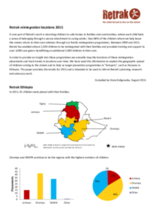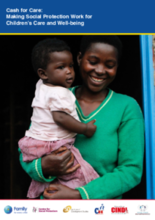Displaying 951 - 960 of 1609
Can children forced to fight be reintegrated back into their families and communities?
Each year Retrak maps the locations of family reintegration placements and tracks trends in locations over time. They have used this information to help them understand the geographic spread of children coming to the streets and to target prevention programmes on ‘’hotspots’’- places from which many children migrate to the streets.
This study examines the experiences of young female survivors of sexual violence in northern Uganda in order to explore the variety of roles (both positive and negative) that informal support networks played in contributing to survivors’ healing, recovery, and reintegration.
Global Strategy – Beyond Detention 2014-2019 is a document released by UNHCR, which aims to support governments to end the detention of asylum-seekers and refugees.
The refresher course will provide the knowledge base and theoretical framework for understanding and developing best practices in alternative care.
The 4Children Initiative (4C) of Catholic Relief Services (CRS) is recruiting a ‘Keeping Children in Healthy and Protective Families’ (KCHPF) Uganda Project Director who will be a member of the CRS Uganda team in Kampala.
This is a report from the International Institute for Child Rights and Development (IICRD) examining the two year (2014-2016) Child Protection Social Cohesion initiative in Burundi and Chad.
While there is a good amount of trafficking research that focuses on Africa, much of the research has greatly neglected child trafficking and its traits within the borders of a particular country. The goal of this article is to take stock of the child trafficking situation within Madagascar’s borders. This article examines the impact of supply-and-demand factors on child trafficking in Madagascar and discusses the approaches that should be used in the implementation of anti-trafficking policies.
Family for Every Child, in partnership with the Centre for Social Protection at the Institute for Development Studies, just announced the launch of its Cash for Care: Making Social Protection Work for Children’s Care and Well-being Report.
According to the Rwanda National Commission for Children, 2294 out of 3323 have obtained foster families through the "Keeping Children in Families" program.




